Trace-Level Quantitation of Tear Gas Lachrymators in Complex Matrices
The Column
GC?GC–TOF-MS is used in forensic analysis for the analysis of tear gas lachrymators. In this article the analysis of a lachrymator standard is shown first, followed by the detection of capsaicin and dihydrocapsaicin at trace levels in a complex extract from contaminated clothing.
GC×GC–TOF-MS is used in forensic analysis for the analysis of tear gas lachrymators. The analysis of a lachrymator standard is shown first, followed by the detection of capsaicin and dihydrocapsaicin at trace levels in a complex extract from contaminated clothing.
Lachrymators are compounds present in tear gas and self-defence sprays — such as pepper spray and "Mace" — that invoke a burning sensation and cause the eyes to water. Dissolved in solvent and contained within an aerosol dispenser, lachrymators are generally used by the police to control large crowds, but are available to purchase for self-defence in some countries. The illegal use of lachrymators therefore requires forensic analysis to assess crime-scene materials for their presence to link a suspect to a crime.
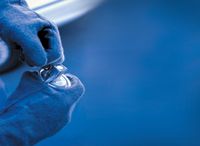
Photo Credit: Thinkstock Images/Getty Images
There are a range of complex matrices encountered in these analyses, and in this article we highlight the example of clothing extracts. The highly complex nature of such samples demands a highly resolving chromatographic technique, and comprehensive two-dimensional gas chromatography coupled with time-of-flight mass spectrometry (GC×GC–TOF-MS) is an ideal choice. In this article, the benefits of this approach are presented, and how TOF-MS can be used to detect and identify trace-levels of lachrymators in these challenging matrices.
Experimental
Samples: A 2000 pg/μL lachrymator standard containing nonivamide, capsaicin, dihydrocapsaicin, 2-chloroacetophenone, and 2-chlorobenzalmalononitrile was used in method development, diluted by factors of ×10, ×50, and ×100. Assessment of real-world method performance used a solvent extract of a section of clothing that had been exposed to tear gas.
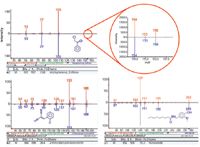
Figure 1: Comparison of acquired spectra (top, red) and the NIST library spectra (bottom, blue) for three of the five lachrymators, displaying very good matches, and preservation of weak molecular ions.
Analysis: The instrument used was a 7890A GC (Agilent Technologies) using an inverse-phase column set (polar to non-polar) equipped with a ZX1 thermal modulator (Zoex Corporation). The detector was a BenchTOF-HD (Markes International) acquiring over m/z 40–450 at a data rate of 50 Hz (200 spectral accumulations per data point). Data visualization and processing was performed using GC Image software (Zoex Corporation).
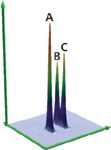
Figure 2: Separation of (A) nonivamide, (B) dihydrocapsaicin, and (C) capsaicin.
Results and Discussion
Analysis of Lachrymator Standards: Figure 1 shows the confident NIST spectral matches obtained for each of the lachrymators, and the absence of mass discrimination — of particular note is the preservation of the molecular ion (m/z 154) for 2-chloroacetophenone. The enhanced peak capacity of GC×GC allowed separation of nonivamide, capsaicin, and dihydrocapsaicin, with excellent peak shape (Figure 2).

Table 1: Signal-to-noise values for the compounds listed for the 20 pg/μL analysis. * EIC summed for m/z 153 + 188.
The signal-to-noise values obtained for each of the standard compounds at the ×100 dilution level (20 pg on-column) are given in Table 1. Using peak area for the extracted ions listed in Table 1, calibration curves were constructed for each of the five lachrymators (Figure 3), and excellent linearity was found, with R2 values >0.999 (three decimal places) for all five compounds.
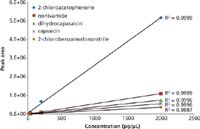
Figure 3: Four-point calibration curves based on GCÃGCâTOF-MS analysis of the five lachrymator standards with a concentration range of 20â2000 pg/μL (20â2000 ppb).
Analysis of Clothing Exposed to Tear Gas: To assess the performance of the method for a real-world sample, the GC×GC–TOF-MS method used to analyze the standards was applied to the separation and analysis of a solvent extract of a sample of clothing that had been exposed to tear gas (Figure 4).
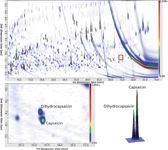
Figure 4: GCÃGCâTOF-MS colour plot of a solvent extract of clothing exposed to tear gas, with expanded regions (below) showing the EIC of m/z 137 and the presence of capsaicin and dihydrocapsaicin. The equivalent surface plot is also shown, illustrating the excellent peak shape obtained.
The analysis allowed identification and quantitation of capsaicin and dihydrocapsaicin within the clothing extract — a great achievement given their presence in trace amounts within this complex matrix (64 ppb and 72 ppb respectively), and the extensive fragmentation that both compounds undergo within the mass spectrometer. The ability of the TOF instrument to generate discrimination-free spectra again gives confident spectral library matches against the NIST database (Figure 5).

Figure 5: Comparison of acquired spectra (top, red) and the NIST library spectra (bottom, blue) for capsaicin and dihydrocapsaicin found in the solvent-extracted clothing.
Conclusion
This article has shown that GC×GC–TOF-MS is ideally suited to the forensic analysis of lachrymators in complex matrices, because of the chromatographic resolving power of GC×GC combined with TOF to generate spectra without discrimination. Of particular note are the excellent linearity and the reference-quality spectra, allowing confident quantitation of target compounds, even at trace levels.
Steve Smith studied in Bristol, UK, for both his B.Sc. and Ph.D., which he obtained in 2008 on innovative work profiling volatile organic compounds for disease diagnosis. Following post-doctoral positions at the University of the West of England and Bristol University, Steve joined Markes International as a Senior Applications Specialist for thermal desorption and TOF-MS in 2011, where he now specializes in GC×GC–TOF-MS.
Laura McGregor received her M.Sc. in chemistry from the University of St Andrews, UK. She completed a further M.Sc. in forensic science at the University of Strathclyde, UK, followed by a Ph.D. in environmental forensics. Laura's research interests include the chemical fingerprinting of environmental contamination using advanced techniques such as GC×GC–TOF-MS, and in 2013 she joined Markes International as a Sales Support Specialist for their TOF-MS products.
David Barden is a Technical Copywriter at Markes International, having joined the company in 2011. David studied natural sciences at the University of Cambridge, and remained at this institution for his Ph.D. in organic chemistry, which he received in 2003. A placement at the European Journals Department of Wiley-VCH, Weinheim, Germany, was then followed by seven years as a Technical Editor for various scientific journals at the Royal Society of Chemistry, Cambridge, UK.
E-mail: enquiries@markes.com
Website: www.markes.com
This article is from The Column. The full issue can be found here:http://images2.advanstar.com/PixelMags/lctc/digitaledition/November20-2014-uk.html

New Method Explored for the Detection of CECs in Crops Irrigated with Contaminated Water
April 30th 2025This new study presents a validated QuEChERS–LC-MS/MS method for detecting eight persistent, mobile, and toxic substances in escarole, tomatoes, and tomato leaves irrigated with contaminated water.
Accelerating Monoclonal Antibody Quality Control: The Role of LC–MS in Upstream Bioprocessing
This study highlights the promising potential of LC–MS as a powerful tool for mAb quality control within the context of upstream processing.
University of Tasmania Researchers Explore Haloacetic Acid Determiniation in Water with capLC–MS
April 29th 2025Haloacetic acid detection has become important when analyzing drinking and swimming pool water. University of Tasmania researchers have begun applying capillary liquid chromatography as a means of detecting these substances.

.png&w=3840&q=75)

.png&w=3840&q=75)



.png&w=3840&q=75)



.png&w=3840&q=75)













